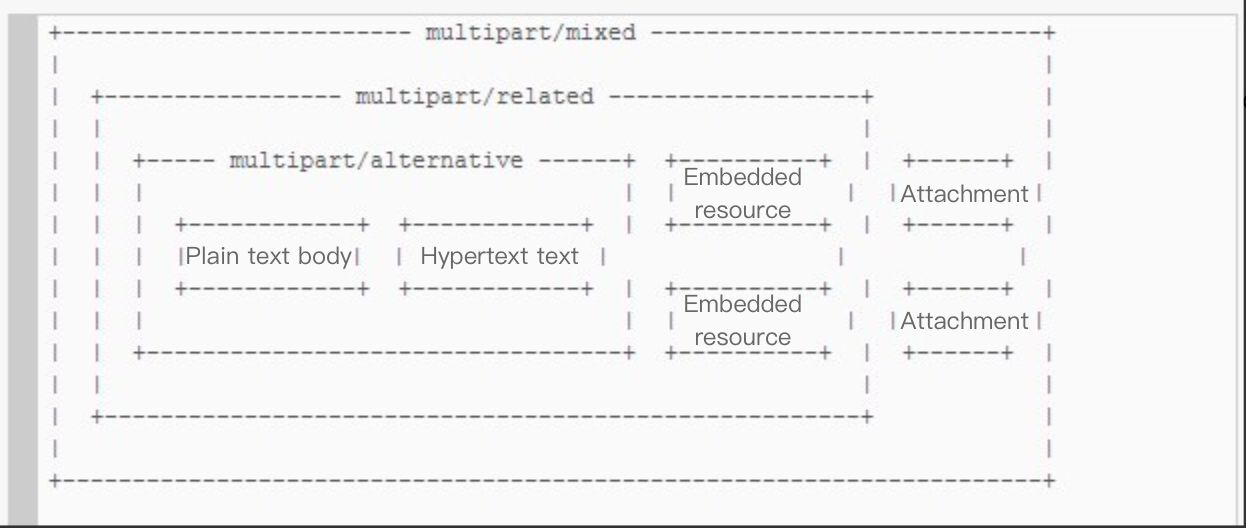发送带附件的邮件
最后更新时间:2025-12-15 12:08:02
通过 SMTP 的方式发送带附件的邮件的方法,即构建一封 MIME 格式的邮件内容。
邮件 MIME 格式
邮件头
包含了发件人、收件人、主题、时间、MIME 版本、邮件内容的类型等重要信息。
说明:
每条信息称为一个域,由域名后加“: ”和信息内容构成,可以是一行,较长的也可以占用多行。
域的首行必须“顶头”写,即左边不能有空白字符(空格和制表符)。
续行则必须以空白字符打头,且一个空白字符不是信息本身固有的(解码时要过滤掉)。
邮件头中不允许出现空行。有一些邮件不能被邮件客户端软件识别,显示的是原始码,就是因为首行是空行。
例如:
内容 | 示例 |
Date | Mon, 29 Jun 2009 18:39:03 +0800 |
From | abc@123.com |
To | abc1@123.com |
BCC | abc3@123.com |
Subject | test |
Message-ID | 123@123.com |
Mime-Version | 1.0 |
域名 | 含义 |
Bcc | 暗送地址 |
Cc | 抄送地址 |
Content-Transfer-Encoding | 内容的传输编码方式 |
Content-Type | 内容的类型 |
Date | 日期和时间 |
Delivered-To | 发送地址 |
From | 发件人地址 |
Message-ID | 消息 ID |
MIME-Version | MIME 版本 |
Received | 传输路径 |
Reply-To | 回复地址 |
Return-Path | 回复地址 |
Subject | 主题 |
To | 收件人地址 |
邮件体
域名 | 含义 |
Content-ID | 段体的 ID |
Content-Transfer-Encoding | 段体的传输编码方式 |
Content-Location | 段体的位置(路径) |
Content-Base | 段体的基位置 |
Content-Disposition | 段体的安排方式 |
Content-Type | 段体的类型 |
有些域除了值之外,还带有参数。值与参数、参数与参数之间以
; 分隔。参数名与参数值之间以 = 分隔。邮件体包含邮件的内容,它的类型由邮件头的
Content-Type 域指出。说明:
常见的简单类型有:
text/plain(纯文本)
text/html(超文本)
multipart 类型,是 MIME 邮件的精髓。邮件体被分为多个段,每个段又包含段头和段体两部分,这两部分之间也以空行分隔。
常见的 multipart 类型有三种:
multipart/mixed
multipart/related
multipart/alternative
可从上述名称,得知这些类型各自的含义和用处。它们之间的层次关系可归纳为下图所示:


如果在邮件中要添加附件,必须定义 multipart/mixed 段;如果存在内嵌资源,至少要定义 multipart/related 段;如果纯文本与超文本共存,至少要定义 multipart/alternative 段。
说明:
代码示例
package mainimport ("bytes""crypto/tls""encoding/base64""fmt""io/ioutil""log""mime""net""net/smtp""time")// Test465Attachment for port 465func Test465Attachment() error {boundary := "GoBoundary"host := "sg-smtp.qcloudmail.com"port := 465email := "abc@cd.com"password := "***"toEmail := "test@test123.com"header := make(map[string]string)header["From"] = "test " + "<" + email + ">"header["To"] = toEmailheader["Subject"] = "Test465Attachment"header["Content-Type"] = "multipart/mixed;boundary=" + boundary//该字段暂时没有用到 ,默认传1.0header["Mime-Version"] = "1.0"//该字段暂时没有用到header["Date"] = time.Now().String()bodyHtml := "<!DOCTYPE html>\\n<html>\\n<head>\\n<meta charset=\\"utf-8\\">\\n<title>hello world</title>\\n</head>\\n<body>\\n " +"<h1>我的第一个标题</h1>\\n <p>我的第一个段落。</p>\\n</body>\\n</html>"message := ""for k, v := range header {message += fmt.Sprintf("%s: %s\\r\\n", k, v)}buffer := bytes.NewBuffer(nil)buffer.WriteString(message)contentType := "Content-Type: text/html" + "; charset=UTF-8"body := "\\r\\n--" + boundary + "\\r\\n"body += contentType + "\\r\\n"body += "Content-Transfer-Encoding: base64\\r\\n"body += "\\r\\n" + base64.StdEncoding.EncodeToString([]byte(bodyHtml)) + "\\r\\n"buffer.WriteString(body)attachment := "\\r\\n--" + boundary + "\\r\\n"attachment += "Content-Transfer-Encoding:base64\\r\\n"attachment += "Content-Disposition:attachment\\r\\n"attachment += "Content-Type:" + "application/octet-stream" + ";name=\\"" + mime.BEncoding.Encode("UTF-8","./go.mod") + "\\"\\r\\n"buffer.WriteString(attachment)writeFile(buffer, "./go.mod")//多个附件往后拼接,最多不能超过10个附件,单个附件不能超过5M,所有附件累计不能超过8-9M,消息体过大会返回EOFattachment1 := "\\r\\n--" + boundary + "\\r\\n"attachment1 += "Content-Transfer-Encoding:base64\\r\\n"attachment1 += "Content-Disposition:attachment\\r\\n"attachment1 += "Content-Type:" + "application/octet-stream" + ";name=\\"" + mime.BEncoding.Encode("UTF-8","./bbbb.txt") + "\\"\\r\\n"buffer.WriteString(attachment1)writeFile(buffer, "./bbbb.txt")defer func() {if err := recover(); err != nil {log.Fatalln(err)}}()buffer.WriteString("\\r\\n--" + boundary + "--")message += "\\r\\n" + bodyauth := smtp.PlainAuth("",email,password,host,)err := SendMailWithTLS(fmt.Sprintf("%s:%d", host, port),auth,email,[]string{toEmail},buffer.Bytes(),)if err != nil {fmt.Println("Send email error:", err)} else {fmt.Println("Send mail success!")}return err}// Dial return a smtp clientfunc Dial(addr string) (*smtp.Client, error) {conn, err := tls.Dial("tcp", addr, nil)if err != nil {log.Println("tls.Dial Error:", err)return nil, err}host, _, _ := net.SplitHostPort(addr)return smtp.NewClient(conn, host)}// SendMailWithTLS send email with tlsfunc SendMailWithTLS(addr string, auth smtp.Auth, from string,to []string, msg []byte) (err error) {//create smtp clientc, err := Dial(addr)if err != nil {log.Println("Create smtp client error:", err)return err}defer c.Close()if auth != nil {if ok, _ := c.Extension("AUTH"); ok {if err = c.Auth(auth); err != nil {log.Println("Error during AUTH", err)return err}}}if err = c.Mail(from); err != nil {return err}for _, addr := range to {if err = c.Rcpt(addr); err != nil {return err}}w, err := c.Data()if err != nil {return err}_, err = w.Write(msg)if err != nil {return err}err = w.Close()if err != nil {return err}return c.Quit()}// writeFile read file to bufferfunc writeFile(buffer *bytes.Buffer, fileName string) {file, err := ioutil.ReadFile(fileName)if err != nil {panic(err.Error())}payload := make([]byte, base64.StdEncoding.EncodedLen(len(file)))base64.StdEncoding.Encode(payload, file)buffer.WriteString("\\r\\n")for index, line := 0, len(payload); index < line; index++ {buffer.WriteByte(payload[index])if (index+1)%76 == 0 {buffer.WriteString("\\r\\n")}}}func main() {Test465Attachment()}
文档反馈

